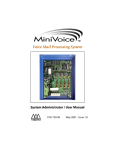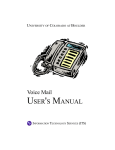Download DEFINITY Enterprise Communications Server
Transcript
DEFINITY Enterprise Communications Server AUDIX Voice Mail User's Guide Prepared for: COMPANY NAME Copyright ©1999 Avaya Communications All Rights Reserved Printed in USA Notice While reasonable efforts were made to ensure that the information contained in the database used to create this document was complete and accurate, Avaya Communications cannot assume responsibility for any errors. Changes and/or corrections to the information contained in the Guide Builder software may be incorporated into the data of future issues. Security Alert: Your Responsibility For Your System's Security Toll fraud is the unauthorized use of your telecommunications system by an unauthorized party, for example, persons other than your company's employees, agents, subcontractors, or persons working on your company's behalf. Note that there may be a risk of toll fraud associated with your telecommunications system, and if toll fraud occurs, it can result in substantial additional charges for your telecommunications services. You and your System Manager are responsible for the security of your system, such as programming and configuring your equipment to prevent unauthorized use. The System Manager is also responsible for reading all installation, instruction, and system administration documents provided with this product in order to fully understand the features that can introduce risk of toll fraud and the steps that can be taken to reduce that risk. Avaya Communications does not warrant that this product is immune from or will prevent unauthorized use of common-carrier telecommunication services or facilities accessed through or connected to it. Avaya Communications will not be responsible for any charges that result from such unauthorized use. Avaya Communications Fraud Intervention If you suspect you are being victimized by toll fraud and you need technical support or assistance, call the National Service Assistance Center at 1 800 628-2888. Federal Communications Commission (FCC) Statement This equipment generates, uses, and can radiate radio-frequency energy and, if not installed and used in accordance with the instruction manual, may cause interference to radio communications. It has been tested and found to comply with the limits for a Class A computing device pursuant to Subpart J of Part 15 of FCC Rules, which are designed to provide reasonable protection against such interference when operated in a commercial environment. Operation of this equipment in a residential area is likely to cause interference, in which case the user at his/her own expense will be required to take whatever measures may be required to correct the interference. Trademark Information INTUITY and Guide Builder are trademarks of Avaya Communications. AUDIX and DEFINITY are registered trademarks of Avaya Communications. Page 1 Welcome With the INTUITY™ AUDIX® messaging system, you have the following capabilities using your telephone: Voice Mail You can record voice messages in advance and send them to the mailboxes of other users without actually calling their telephones. Other users also can record and send voice mail messages directly to your mailbox. When convenient, you can access your mailbox to get those messages. Call Answering The system answers calls when you can't. Callers may then leave messages in your "mailbox." Later, you can access your mailbox to get those messages. Call Your Mailbox Your mailbox stores incoming and outgoing voice and fax messages and headers. To call the first time (set-up): Pick up the handset and enter: 1. Your system-access number (5555) or press VM ACCESS. 2. Your extension, followed by #. 3. Your default password (1234), followed by #. 4. The system will guide you through recording your name for system announcements and greetings. “Press 1 and at the tone, record your name. When finished, press 1 again.” 5. From the Activity Menu, press 5 then 4 to change your password. 6. If you wish to record a personal greeting now, press * then R (or 7) to return to the Activity Menu then press 3 to access greetings. See Record Greetings in this guide book for more information. SECURITY ALERT: Don't use a password that uses: Page 2 • Ascending or descending digits (for example, 1234 or 4321) • The same digits (for example 0000) • Digits matching your name or initials (for example, 5646 for John) • The current year (for example, 1996) • The same number as your extension (for example, extension 3455, password 3455) • A reverse extension (for example, extension 3455, password 5543) • Numbers that identify you, such as your social security number, employee ID, room number, or department • A programmable function key or speed-dial key You should change your password at least once every three months. Get Around in Your Mailbox When you call your mailbox and login, you reach the Main Menu. The Main Menu is also referred to as the Activity Menu. Activity Menu Options 1 Record and send messages Create, address, and select delivery options for mail messages. 2 Get messages Listen to, respond to, and delete messages. 3 Create greetings Create, change, and activate personal greetings. 4 Outgoing and filed messages Determine the status of and listen to messages you previously created. 5 Personal options Set up mailing lists, personal directory, recorded name, addressing sequence, and password. 6 Outcalling Select if, when, and where the system calls you when new messages are delivered to your mailbox. Voice Prompts and Help After you log in, the voice prompts always tell you what to do. • For help at any time, press * H ( * 4 ) to get a list of your current options, or • To return to the Main Menu, press * R ( * 7 ). + Tips Page 3 Usually, you can dial through a voice prompt to enter a command without waiting for the prompt to finish. But you can't dial through error messages and prompts the system wants you to hear. Basic Commands * 4 (or * H ) Help * 7 (or * R ) Return to Main Menu * 9 (or * W ) Wait * * 6 (or * * N ) Look up number/name * * 9 (or * * X ) Exit system *0 * 3 (or * D ) Transfer call to operator Delete * * 8 (or * * U ) Undelete * * 4 (or * * H ) Hold message in category * 8 (or * T ) Transfer out * * 7 (or * * R ) Log in again Use while listening to messages 9 Increase speed 8 Decrease speed 4 Increase volume 7 Decrease volume 6 Skip forward 5 Skip backward Use while addressing Page 4 * 2 (or * A ) Alternate between name and number addressing * 5 (or * L ) Use mailing list for addressing Record a Greeting for Callers When you don't answer your telephone, the system works just like an answering machine. The system sends the call to your mailbox. Then, the caller either hears a system greeting or a greeting you've recorded. You can record and store several personal greetings, each for a specific situation. You can manually activate each greeting as needed, or you can keep a number of greetings active at once (see "Create and Use Multiple Personal Greetings"). Recording Your Basic Greeting To record your basic greeting: 1. Press 3 1 from the Main Menu. Speak your greeting at the tone. You may need to enter a greeting number before you speak your greeting. 2. (Optional): Press one of the following: 1 23 *3(*D) 3. Pause (and 1 again to continue recording). Play back. Delete and begin again. Press # to approve. Do one of the following: • Follow the prompts to activate the greeting. • Press # to leave the greeting inactive. Page 5 Get Messages You've Received You can listen to: • Message headers, which tell you: * Who sent the message * When the message was sent and how long (in seconds and/or pages) it is • Voice messages Listening to a Voice Message 1. Press 2 from the Main Menu. Listen to the header of the first message. 2. Press any of the following: 0 Listen to the voice message, if any. Press 0 again to rewind and listen from the start. 2 Rewind to the start of the message. Press * 2 to skip to the previous message. 3 Play back the header after pressing 2. 9 Increase speed 8 Decrease speed 4 Increase volume 7 Decrease volume 6 Skip forward 5 Skip backward Responding to a Message 3. (Optional): Press 1, and one of the following: 0 Call the sender. In this case, you exit your mailbox. 1 Reply to the sender by voice mail. 2 Forward with comment at the beginning. 3 Forward with comment at the end. 4 Record and address a new message. If you press any key other than 0, continue with Steps a, b, and c. Page 6 a. Record and address your message, if necessary. See Step 4 in "Sending a Voice Message". (If you're replying to the sender, you don't need to address the message.) b. Press # to approve, if necessary. c. Press # to send, or enter a delivery option, then press #. See "Enhanced Delivery Options". Acting on a Message 4. Press one of the following: *D(*3) **U(**8) # **H(**4) *# + Tips Page 7 Delete the message. Undelete the message. Save and skip to the next message. Hold the message in the current category and skip to the next message. Skip to the next message category. Your mailbox keeps incoming messages until you delete them or until the system deletes them automatically. Because space is limited, it is wise to review and delete messages regularly. Record and Send Messages Sending voice, fax, and voice-fax messages from your mailbox are similar tasks, but there are important differences: • You can record and send a voice message from any telephone. Sending a Voice Message 1. Press 1 from the Main Menu. 2. Record your voice message at the tone. (Optional): To edit, press one of the following: 1 Pause. Press 1 again to continue recording. 23 Play back. * D (or * 3 ) Delete (and begin again). 3. Press # to approve the message. 4. To address, select one or more of the following: • Enter the user's extension and press #. • Press *2. Spell out the user's name on the telephone keypad and press #. You can switch back and forth between addressing by extension and addressing by name by pressing *2. • To send to a mailing list: a. Press * L to access a list. b. Enter the list owner's extension and press #. If you're the owner, press #. c. Enter the list ID (name) and press #. 5. Press # to approve the address. 6. Press # to send. Or, enter other options, and press # to send. See "Enhanced Delivery Options" later in this book. Page 8 Enhanced Delivery Options When you have created/addressed a message and are ready to send, several delivery options are available. Select any of the following: 0 Review delivery options 1 Make your message private. (Press 1 again to undo.) NOTE: The person receiving a private message can't forward it.. 2 Make your message priority. (Press 2 again to undo.) NOTE: The system places a priority message in a mailbox ahead of all other messages, regardless of when the other messages were received. 3 Schedule delivery. (Press 3 again to undo.) To schedule delivery: 4 a. Enter the delivery time (405 = 4:05). b. Enter 2 ( A ) for AM or 7 ( P ) for PM and press #. c. Enter month and day of delivery (502 = May 2nd) and press #. d. Press # to approve or * 3 (or * D ) to start over. File a copy. (Press 4 again to undo.) Leave a Message When a User Doesn't Answer If you call a user who doesn't answer, your call goes to the user's mailbox. At this point, you have several options for making full and efficient use of the system. When you hear the user's mailbox greeting, do any of the following: 1. (Optional): Press 1 to skip through the greeting (if you won't be missing information in the greeting). 2. Record your voice message at the tone. Leave a detailed message (it's generally more efficient to convey information than just requesting a return call). 3. (Optional): To edit, press one of the following: 1 23 * D (or * 3 ) Page 9 Pause. Press 1 again to continue recording. Play back. Delete (and begin again). 4. Hang up, or press # to approve the message and enter other options. See "Enhanced Delivery Options" later in this book. Before or after leaving a message, you can: • Transfer to another extension: a. Press * T ( * 8 ). b. Enter the extension. c. Press #. NOTE: If you record a message and either hang up or go to another option, the system automatically delivers your message to the person you are calling. To prevent delivery of your message, you must delete it with * D ( * 3 ). Page 10 Create Mailing Lists A mailing list is a list of users to whom you might send a message simultaneously. A mailing list can save you a lot of time if you periodically send messages to the same group or groups of people. 1. Press 5 1 1 from the Main Menu. 2. Enter the list ID (up to six letters or digits) and press #. 3. Press one of the following: 1 Make the list private. 2 Make the list public. 4. Enter an address and press #. 5. Repeat Step 4 until the list is complete. 6. Press # to approve. + Tips When creating a list, you can also include an existing list by entering * L ( * 5 ) at step 4. Deleting Addresses from a List There are two ways to delete addresses: Review the list until you find an address, then press * D ( * 3 ) or • At step 4 (when creating a list), enter the address again. NOTE: Though it appears that you have added a recipient twice, by deleting that number immediately after you add it, it will be deleted. Repeat for other addresses. Scanning List Summaries 1. Press 5 1 2 from the Main Menu. 2. Listen to the list summary. 3. Press any of the following: # *D(*3) 0 Page 11 Skip to next list. Delete the entire list. Review/modify list members. See "Reviewing and Modifying a List" Reviewing and Modifying a List 1. Press 5 1 3 from the Main Menu. 2. Enter the list owner's extension and press #. (If you own the list, only press #.) 3. Enter the list ID and press #. 4. Listen to the first name, then press any of the following: # *D(*3) Delete the name. 2 Repeat the name. 22 Return to the previous name. *1 Review from the beginning. 1 *# 5. Skip to the next name. Add entries or change public/private status, then do the following: a. Press Y ( 9 ) or N ( 6 ) to change the status. b. Enter or speak the address c. Listen to the name. d. Repeat steps b and c for each addition. Stop reviewing/modifying specified entries. Press # when finished reviewing. Page 12 Create and Use Multiple Personal Greetings After you have recorded several personal greetings, you may want to assign those greetings to specific types of incoming calls. Besides the basic mode of using one greeting for all calls, you can set up specific greetings for: • internal and external calls (may not be available on all systems) • busy and no-answer calls • prime-time internal, prime-time external, and out-of-hours calls (may not be available on all systems) • prime-time busy, prime-time no-answer, and out-of-hours calls (may not be available on all systems) The first step is to define the types of calls you want to differentiate; then move on to changing call-type definitions and assigning greetings to call types. Call Types Internal Calls from inside your business location. External Calls from outside your business location. Busy Calls that come in when you're using your telephone line(s). No answer Calls that come in when you don't answer. Out-of-hours Calls that come in after standard business hours (as defined by your system administrator). (You must activate weekend greetings manually.) Defining Call Types the First Time 1. Press 3 4 from the Main Menu. 2. Press one of the following: 3. 1 Differentiate internal/external calls. 2 Differentiate busy/no-answer calls. Press one of the following: 3 Differentiate out-of-hours calls. 4 Make no distinction between prime time and out-of-hours calls. Changing Call Types 1. Press 3 4 from the Main Menu. 2. Press any of the following: Page 13 3. 1 Differentiate internal/external calls. 2 Differentiate busy/no-answer calls. 3 Differentiate out-of-hours calls. 4 Turn off out-of-hours differentiation. 5 Use a single greeting for all calls (negate call-type definition). Press # to approve, then see "Assigning Greetings to Call Types". Assigning Greetings to Call Types 1. Press 3 from the Main Menu. 2. Listen to the summary of active greetings. 3. Press 3 to activate a greeting. 4. Enter a number (0 to 9) to indicate which greeting you want to assign to a call type. 5. Press any of the following: 1 Use the greeting for each call type. 2 Use the greeting for internal (or busy) calls. 3 Use the greeting for external (or no-answer) calls. 4 Use the greeting for out-of-hours calls. 5 Use a single greeting for all calls (negate call-type definition). 6. Press # to approve. 7. Press * R ( * 7 ) to return to the Main Menu. NOTE: To set up different greetings strictly for prime-time and out-of hours calls, you must assign the same greeting to the two prime-time call types (internal/external or busy/noanswer ) and a second greeting for out-of-hours calls. Activating Previously Recorded Greetings 1. Press 3 3 from the Main Menu. 2. Enter the greeting number. 3. Listen to the prompts for instructions on activating call types. Scanning All Greetings 1. Press 3 2 from the Main Menu. 2. Listen to the status of the first greeting. 3. Press any combination of the following: 0 Page 14 Listen to a greeting. 1 *D(*3) 4. Re-record a greeting. Delete and skip to the next greeting. 2 Return to the previous greeting. # Save and skip to the next greeting. Press * # to quit scanning. Page 15 Check and Reuse Outgoing or Filed Messages After you've sent a message, it progresses through a series of status categories. These categories are: Undelivered Not yet sent because it's scheduled for future delivery. You can listen to, re-address, and re-record the message prior to delivery. Delivered Delivered but not yet listened to. Accessed Delivered and listened to. Undeliverable Can't be delivered, usually because the recipient's mailbox is full. You can listen to, re-address, and rerecord the message. Filed Copies and saves the outgoing message to re-send and/or modify. You can check the status of outgoing messages. Or you can select, modify, and resend them. Checking the Status of Messages You've Sent To check the status of outgoing messages: 1. Press 4 from the Main Menu. 2. Listen to the first category and message header. 3. Press any or none of the following: 0 Listen to the message. 1 Modify/resend modified messages. 23 Play back the message header. *D(*3) Delete and skip to the next message. 22 Return to previous messages. # Save and skip to the next message. *# Skip to the next message category. NOTE: For delivered or accessed messages, you can listen to the headers only. After you review an accessed message header, the system deletes the header automatically. Changing and Resending a Message 4. Press 1 to change and/or re-send the selected message. • Press # to resend the message as is. • To change the message: Page 16 a. Press 1. b. Speak the message at the tone. c. (Optional): To edit, press one of the following: 1 Continue recording. 23 Play back. *D(*3) d. Delete (and begin again). Press # to approve. Resending a Message 5. For filed and undeliverable messages: a. Enter address(es) or list via * L ( * 5 ). b. Press # # to approve and send immediately, or enter delivery options and press #. For undelivered messages: a. Enter additional addresses and press #. b. Press * 1 to review and edit original addresses. c. Change delivery times or options. + Tips You can change/resend three types of outgoing messages: Undelivered (scheduled for future delivery) Undeliverable (incorrect address or recipient's mailbox is full) Filed Press # # to resend an undelivered message to the original recipient only. If you resend a filed message, it leaves the file cabinet portion of your mailbox. You must file a copy again to retain it. Page 17 Create a Personal Directory You can create a personal directory of abbreviated names (aliases) for frequently used addresses. It's essentially a sophisticated speed-dialing feature. NOTE: You must be addressing by name * A ( * 2 ) to use an alias as an address. Creating and Appending a Directory 1. Press 5 2 1 from the Main Menu. 2. Enter an address and press #. You can enter most addresses in your personal directory using name or number addressing. However, you must identify an email-only user with name addressing. 3. Listen to your entry's address. If the name is incorrect, press * D ( * 3 ) to delete and repeat step 2. 4. Enter your abbreviated version of the address (up to 10 characters) and press #. 5. Repeat Steps 2 to 4 to add more names to your personal directory. 6. Press # to approve. Reviewing and Deleting Entries from a Directory 1. Press 5 2 from the Main Menu. 2. Press: • 2 to review all aliases. While listening to each entry, press: # *D(*3) Skip to the next alias. Delete. 22 Return to the previous alias. ## Stop reviewing. • 3 to review specific aliases: 3. a. Enter an alias to review and press #. b. Listen to the corresponding address. c. Press * D ( * 3 ) to delete. d. Repeat for more aliases. e. Press * # to stop reviewing. Press * R ( * 7 ) to return to the Main Menu. Page 18 + Tips The system refers to your personal directory automatically each time you enter a name address. The system doesn't care what numbers or letters you use for each alias. A common method is to use two- or three-letter abbreviations that use people's initials. For example, for Mel F. Lewis, you might enter M F L instead of the longer name. You can also use an alias when transferring out of the system with * T ( * 8 ). How to Use Directory Assistance If you know the name of a person, you can use directory assistance to find that person's extension. If you know the extension, you can use directory assistance to find the name of the person with that extension. 1. Press * * N ( * * 6 ) from anywhere in the system. 2. Do one of the following: • To hear the extension number associated with a name, enter the name (last name first, with no spaces between the first and last name), then press #. • To hear the name associated with an address, press * A ( * 2 ), enter the address, then press #. + Tips The extension you hear associated with a name is not always the entire address. Add the appropriate prefix numbers for users on remote systems. Page 19 Scan Messages Quickly The autoscan option lets you get messages automatically with just 2 button presses. Autoscan is useful for car telephone users because it requires fewer button presses. 1. 2. Press 7 from the Main Menu, then press: 1 Scan headers and messages. 2 Scan headers only. 3 Scan messages only. Use the respond and act on options as necessary. Page 20 Notify Yourself When You Get New Messages Outcalling lets the system call you when you get new messages. Here's how it works: 1. Your mailbox receives a new message. 2. The system calls you at home, at a different office, on your pager, wherever. 3. The system tells you to log in. 4. You log in and press 2 to get messages. + Tips Use outcalling to call you at your extension if you don't have a message-waiting light. Set Your Outcalling Number Set your outcalling number as follows: 1. Press 6 to select outcalling administration. 2. Press 1 to change the outcalling number. 3. Enter the new number (up to 60 characters [depending on administration], including pauses), and then press #. For a pager, the following rules apply: Include a 1.5 second pause at any point in the number Enter *. Include a pound sign at the beginning of the number Enter #. Include a pound sign other than at the beginning of the number. Enter * #. In this case, the system recognizes * as a marker to include #, not as a 1.5 second pause. • For example, for the system to reach your pager with an outcall, it may need to dial a 9, wait 1.5 seconds, dial a seven-digit number, then dial # and a three-digit number, followed by a pound. You enter the following: 9*1234567*#123# Scheduling Outcalling To specify a daily time period for the system to place an outcall, do the following: 1. Press 6 to select outcalling administration. 2. Press 2 to schedule outcalling. 3. Do one of the following: • To be called any time (day or night), press 1. • To be called during prime time (set by your system administrator), press 2. Page 21 • To listen to the scheduling restrictions indicating when outcalling is available (set by your system administrator), press 4. • To specify a time period for the system to place an outcall: a. Press 3 to select a time period for outcalling to start and end. b. Enter the starting hour and minutes (either one or two digits for the hour and two digits for the minutes). For example, press 2 0 5 for 2:05. c. Press A (2) for A.M. or P (7) for P.M., and then press #. d. Enter the ending hour and minutes. e. Press A (2) for A.M. or P (7) for P.M., and then press #. f. If the schedule is not correct, press * D to delete, and re-enter the time period. g. Press # to approve the schedule. Turning Outcalling On/Off The system saves your outcalling number even when you turn off outcalling. When you turn on outcalling again, you can use the original number and schedule you set without re-entering the number. After logging in, press 6 to select outcalling administration. Press Y (9) to turn outcalling on, or press N (6) to turn outcalling off. If you turn outcalling on, you must select either 1 to activate outcalling for all new messages, or 2 to activate outcalling for only new Priority messages (see "Priority Outcalling" later in this section). Responding to an Outcall After you answer an outcall, you have three choices: Receive the messages 1. Log into your mailbox. 2. Listen to the messages. Cancel outcalling Press * # to cancel the outcall; the system won't call again until there are more new messages. Hang up Hang up without logging in or canceling the outcall; the system reschedules the outcall for the next administered outcalling interval. NOTE: Your phone company's Central Office can take up to 30 seconds to disconnect the system after you have responded to an outcall. If the system is still connected and you need to make another call, press * * X to force the system to hang up. Priority Outcalling You can opt to be called only for all new priority messages. If your mailbox has new priority messages when you turn on priority outcalling, the system will not place an outcall until another new priority message is received. If you receive a priority message during off hours (when you have specified that outcalls are not to be placed), the system waits until the time permitted for outcalling to make the outcall. Page 22 More Tips and Highlights General Message Handling Log in quickly From your telephone, dial the system extension, press # (you don't need to enter your extension), and enter your password. Log in from a system telephone From any telephone connected to your company's system, dial the system extension, then enter your extension and password. Log in from a remote telephone From any telephone not connected to your company's system, dial the complete system number, including local prefix and the area code if long distance, then enter your extension and password. Dial through If you know which buttons to push, push them without waiting for the system to respond. NOTE: You can't dial through error beeps and important system messages. For Help, press * H ( * 4 ). The system states your current options or the next step. Getting Messages Use playback controls When listening to messages, you have controls for loudness, speed, stepping back and forth, pausing, and repeating messages. Record a personal greeting Replace the automatic system greeting with your personal hello. Tell callers they can press 1 to skip your greeting and press * H ( * 4 ) for Help. Change your greeting daily to match your schedule. Delete old messages Your mailbox has limited space. When it's getting full, the system tells you. Delete messages or greetings you don't need. Answer messages from your mailbox You can answer a message sent by another user immediately after listening to it, either by pressing 1 0 to call the person or by sending the caller a return voice mail message by pressing 1 7. Forward messages You can forward a message to another user or a list of users immediately after listening to it. After you forward it, you return to the original place in your mailbox. To forward to a mailing list, press * L ( * 5 ) to specify the list's address. Page 23 Scan messages quickly You can automatically play all your messages by pressing just two buttons, 7 plus either 1 to scan messages and headers, 2 to scan headers only, or 3 to scan messages only. Scanning is especially useful with a car telephone. Turn off your mailbox when away Turn off the call answer capability of your mailbox for times when you're on vacation or away from your office for awhile. This prevents your mailbox from filling up and encourages people to seek other personnel for assistance. It also helps save resources on your AUDIX system. To do this, press 5 7. Leaving Messages When No One Answers Use playback and record controls To listen to and edit the messages you leave when there's no answer, you have many controls. Bypass greetings and record immediately You don't have to listen to another user's call answer greeting. You can, instead, press 1 to bypass the greeting and begin recording immediately. Use directory assistance If you don't know the extension of another user, log into your mailbox, press * * N ( * * 6 ) and enter the person's name, last name first. The system tells you the extension. Mailing Messages Make messages priority When you want someone to listen to your message right away, send it as a priority message. Make messages private When you want to prevent another user from forwarding a message you send, make it private. Save messages you send Before sending a message, you can save it in your outgoing message file. Retrieve the message later to use again. Check on receipt of messages you send After you send a message, check your Outgoing Message file to see if the message was delivered and if the person listened to it. Delete outgoing/filed messages Delete messages filed in the Outgoing Message file. Saved outgoing messages use system storage unnecessarily. Schedule delivery Schedule a message for delivery to others at a specified time and date. Use the system as a calendar/reminder by scheduling messages to yourself. Use mailing lists Create a mailing list of extensions. Then send your message to one destination -- the mailing list. All extensions in the list receive the message. You can also forward messages to a mailing list. Page 24 Send messages to a name, not an extension When you send a message and don't know the extension of the recipient, press * A ( * 2 ). Then enter the person's name, last name first. Pressing * A ( * 2 ) switches you back and forth between extension and name. You can also use Spoken Name Addressing to address a message by simply speaking the name of the recipient without using the keypad to enter the person's name. If Spoken Name Addressing is not your default addressing method, press *MO to access spoken name addressing. Terms and Concepts Messages Incoming Messages (Messages You Receive) New – Voice messages you haven't retrieved. Unopened - Voice message headers to which you've listened, but have not yet listened to the message itself. Old – Voice messages to which you've listened or printed, but haven't deleted. Outgoing Messages (Messages You Send) Delivered - Messages that the user has received but hasn't listened to. Accessed - Messages the user has received and listened to. Undelivered - Messages not yet sent but scheduled for future delivery. You can listen to, re-address, and re-record these messages any time before delivery. Undeliverable - Messages that could not be delivered, normally because the intended user's mailbox is full. You can listen to, re-address, and rerecord these messages. Filed - Copies of outgoing messages that you've saved to re-send and/or modify. Header A summary of an incoming voice message (equivalent to a return address and postmark on a letter). It may include the length of a voice component in minutes and/or seconds. Voice message - "Message from Norman Bates, received 7:34 AM, Friday, April seventh, 70 seconds, extension 77956." Page 25



































